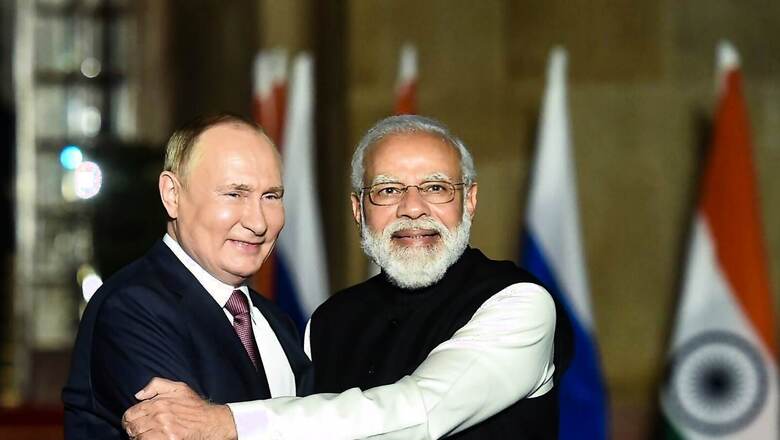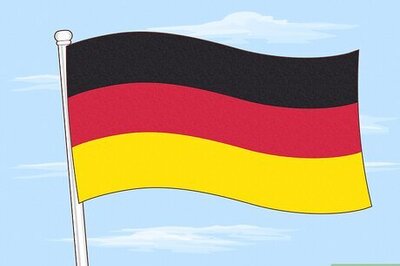
views
Russian President Vladimir Putin visited India for a few hours on December 6, 2021 for the 21st bilateral Annual Summit. It is noteworthy that Putin undertook this visit although the numbers of Covid-19 cases in Russia continue to surge and the threat of confrontation over the Ukraine border continues to rise. This is testimony to the strategic significance that Putin attaches to the relationship with India. On September 17, 2021, Putin had declined at the last minute to travel to Dushanbe, Tajikistan, for the Shanghai Cooperation Organisation (SCO) Summit because of the high incidence of Covid-19 cases in Russia.
This is only the second visit by Putin outside Russia — the first having been to Geneva in June this year for a bilateral Summit with US president Joe Biden. Through this visit Putin has delivered an unambiguous message that notwithstanding the doubts and speculation about the health of the India-Russia partnership, it continues to be vibrant. In addition, the fact that the visit to India has taken place before Putin went to China, which in recent years has emerged as a consequential partner to Russia, is also an assertion that India-Russia relationship is pivotal.
The timing of the visit is crucial as currently an intense churn in regional and global geopolitics is taking place. The visit has demonstrated that notwithstanding the rapid flux in international affairs, strong India-Russia relations are a constant.
The outcome of the brief visit was also momentous. Twenty-eight agreements were signed between the two sides, both at the government as well as at the private sector level. They clearly demonstrate the extensive gamut of the bilateral engagement. The first 2+2 Dialogue between the defence and foreign ministers of the two countries took place. It provided an opportunity to share views about the current security, political and economic situation in the world.
Considerable attention was paid to trade and investment relations. Putin said that trade between the two sides had declined by 17% last year but has grown by 38% in the first nine months of the year. The two countries have fixed a target of bilateral trade of $30 billion and investment of $50 billion by 2025. While it might be possible to achieve the target of investment which has already reached around $38 billion, it appears difficult to reach the bilateral trade target which is languishing around sub-$10 billion level even now.
It was agreed to give a strong impetus to ties in the traditional areas of collaboration including defence, nuclear energy, fossil fuels, counter-terrorism, drug trafficking, space, health and others.
In the area of defence, the most important decision was to commence manufacture of more than 700,000 assault AK-203 rifles with transfer of technology under the ‘Make in India’ programme.
As evidence of the strategic autonomy exercised by India, it has imported and started receiving components of the S-400 Triumf ballistic missile defence system worth more than $5 billion. Construction of the first of the four frigates of P1135.6 class “Tushil’’ has commenced recently. Two of these will be manufactured in Russia, and two in India. The two sides are engaged in talks for procuring MiG-29K for the IAC-1, more T-90 tanks as well as additional Su-30 MKI for the Indian Air Force.
Military-technical cooperation continues to be a lynch-pin of the bilateral time-tested partnership. The Bilateral Defence Agreement was extended for a further period of 10 years up to 2031. Russia has continued to supply essential military equipment as requisitioned by India during visit of Defence Minister Rajnath Singh to Moscow in September 2020 in the wake of the Galwan attack by China. This was done in spite of demand by China to delay supplies of crucial items to India.
Some of the new areas identified for cooperation include Central Asia, the Far East Region of Russia and the Arctic. All these regions face a threat of growing dominance by China which would decrease Russia’s influence in these regions.
Russia’s Far East is extremely well endowed with natural and mineral resources like oil, gas, iron ore, copper, diamonds, gold, silver, etc. It encompasses about 40% of Russia’s land area but accounts for only 5% of the total population. It is in urgent need of investment and trained manpower. Prime Minister Narendra Modi had extended a Line of Credit of $1 billion during his visit to Vladivostok in 2019 to explore opportunities for greater Indian engagement with that region. In the post-pandemic period, this region beckons for greater Indian engagement. Indian participation in this region is particularly welcome on account of the increasing danger of Chinese intrusions which appears to have grown in recent years.
The Arctic is a promising region for bilateral collaboration. Putin had invited India to cooperate with it in the region during Modi’s visit in 2019. The region is extremely rich in mineral resources including hydrocarbons and fossil fuels. The region also faces risk of increased Chinese presence which has declared itself as a “Near Arctic State” although no such concept exists in the constitution of the Arctic Council.
Russia has gone deep into the embrace of China as a result of sanctions imposed by the US and the West in the wake of the Ukraine crisis and accession of Crimea to Russia in 2014. India has moved closer to the US in strategic and military fields on account of the threat it confronts from China on the northern land frontier as well as the Indian Ocean.
Putin’s visit sought to underline and emphasise the multi-polar nature of the world geopolitical architecture. The vibrant India-Russia strategic partnership has sent out a clear message that the world is evolving into a multi-polar structure. Putin’s visit was a strong reminder that the world is entering an era of greater pluri-lateralism, one that recognises the shortcomings of multilateralism, the limits of bilateralism and the untenability of unilateralism, from whichever quarter.
Afghanistan emerged as a major subject of bilateral deliberations between Modi and Putin as also during the 2+2 deliberations. There were differences in the perspectives of the two sides on Afghanistan in recent years. Russia’s assessment changed drastically in mid-August 2021 when the Taliban took over Kabul and there was no indication that it would abide by its commitments of forming an inclusive government, respecting the rights of minorities as well as women and children, and will not allow its territory to be used by terrorist groups for attacks against neighbors. Today there is near-complete convergence in the viewpoint of both India and Russia on the way forward in Afghanistan.
Putin’s short but highly consequential visit and launch of the 2+2 Dialogue have imbued new energy and dynamism into the bilateral partnership. There might be a few areas of divergence between the two sides, but the convergences are much larger. The trust between PM Modi and President Putin will continue to navigate the bilateral partnership and make it even more robust.
The writer is executive council member, Manohar Parrikar Institute for Defence Studies and Analyses, president, Institute of Global Studies, Distinguished Fellow, Ananta Aspen Centre, and former Ambassador of India to Kazakhstan, Sweden and Latvia. The views expressed in this article are those of the author and do not represent the stand of this publication.
Read all the Latest Opinions here




















Comments
0 comment